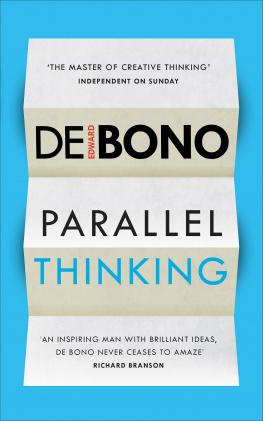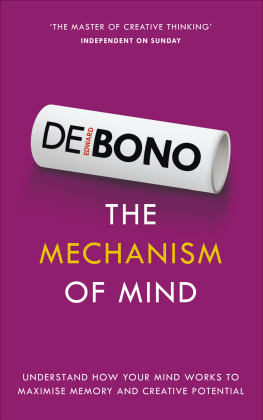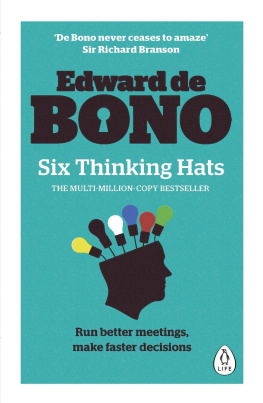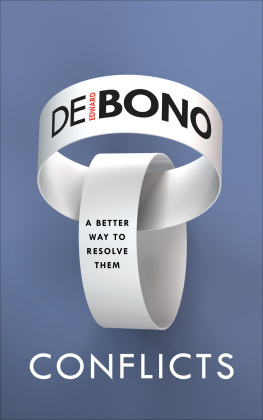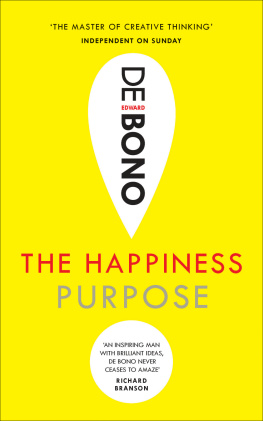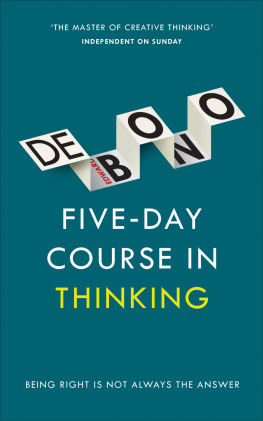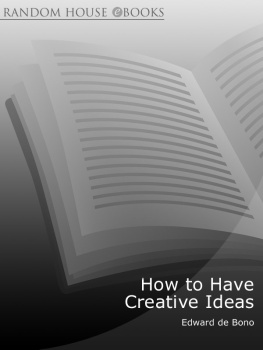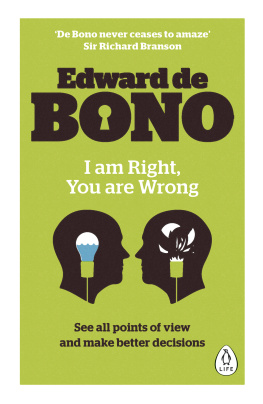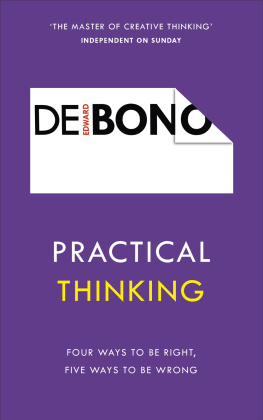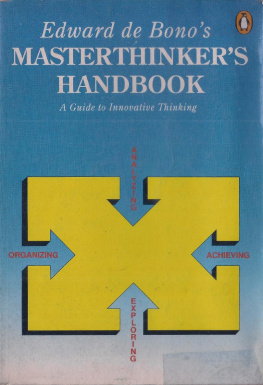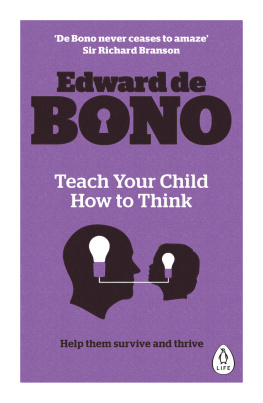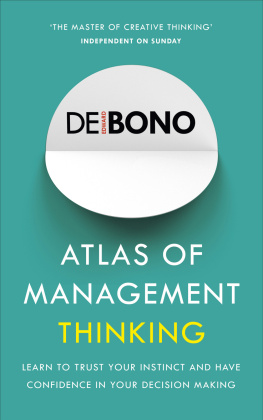CONTENTS
ABOUT THE BOOK
Western thinking is failing because it was not designed to deal with change
In this provocative masterpiece of creative thinking, Edward de Bono argues for a game-changing new way to think.
For thousands of years we have followed the thinking system designed by the Greek philosophers Socrates, Plato and Aristotle, based on analysis and argument. But if we are to flourish in todays rapidly changing world we need to free our minds of these boxes and embrace a more flexible and nimble model.
This book is not about philosophy; it is about the practical (and parallel) thinking required to get things done in an ever-changing world.
ABOUT THE AUTHOR
Edward de Bono studied at Christ Church, Oxford (as a Rhodes Scholar). He also holds a PhD from Cambridge and an MD from the University of Malta. He has held appointments at the universities of Oxford, London, Cambridge and Harvard.
In 1967 de Bono invented the now commonly used term lateral thinking and, for many thousands, indeed millions, of people worldwide, his name has since become a symbol of creativity and new thinking. He has written numerous books, which have been translated into 34 languages, and his advice is sought by Nobel laureates and world leaders alike.
ALSO IN THE SERIES
The Six Value Medals
How to have a Beautiful Mind
How to have Creative Ideas
Think!
Six Frames
Serious Creativity
Lateral Thinking
The Mechanism of Mind
H + (Plus) A New Religion?
PREFACE
I want to make it clear at the outset that it is not my intention to demonstrate that Western thinking is bad and that Eastern thinking is good. Eastern thinking, if there is such a collective entity, does not come into this book except occasionally and indirectly. The contrast I wish to highlight is between traditional Western thinking with its judgemental and adversarial habits and parallel thinking with its emphasis on possibility and designing a way forward.
My intention is to show that, in a changing world, Western thinking is failing. It is failing not because it is being applied ineffectively but because there are deep-seated inadequacies and dangers in the system itself.
Western thinking is failing because it was not designed to deal with change.
Does this mean that the traditional Western thinking system that was fashioned by what I refer to as the Greek Gang of Three (Socrates, Plato and Aristotle) was wrong? To answer with a simple Yes or No would be to use the judicial terminology of the system itself. Western thinking is failing because it was not designed to deal with change. The main fault is the esteem, reverence and complacency with which we have allowed ourselves to be satisfied with an inadequate system.
Digging for gold is not the same as designing and building a house. Analysis and judgement are not enough when there is a need to design a way forward.
The purpose of this book
It is not my intention simply to point out the limitations and faults of the traditional system. That, again, would be to use the habits of that system. I intend to lay out the nature and operating methods of a different thinking system. This is parallel thinking. In this method, instead of using the boxes and judgements of traditional thinking, we design forward from a field of parallel possibilities. I hope to make clear that this is a fundamentally different method of thinking.
Parallel thinking is more concerned with what can be than with what is.
If you want to know what I hope to achieve in this book then you could turn to my conclusions in the summaries .
If you have been educated entirely within the traditional Western thinking system devised by the Gang of Three, that thinking system will appear complete, comprehensive and perfect. You will see the world through the belief system that underlies that system. You will argue about the world using the devices provided by that system.
Yet in a rapidly changing world the traditional thinking system is failing because it was never designed to deal with change. The system is inadequate. It is dangerous. It is complacent.
This is a book not about philosophy but about the practical operation of thinking. It is my intention to compare the traditional Western thinking system with parallel thinking. There are some very fundamental points of difference.
Traditional thinking is concerned with search and discovery. Parallel thinking is concerned with design and creation.
Traditional thinking is based on ruthless and immediate judgement (yes/no, right/wrong, true/false). Parallel thinking accepts possibilities without judging them.
Traditional thinking is concerned with rock logic and is. Parallel thinking uses the flow of water logic and to.
Traditional thinking uses hard-edged judgement boxes, definitions and categories. Parallel thinking uses soft edges, overlap, flagpoles and spectra.
Traditional thinking sets up dichotomies and contradictions in order to force a choice. Parallel thinking embraces both sides of a contradiction and seeks to design a way forward.
Traditional thinking believes that information and judgement are enough. Parallel thinking looks to the deliberate generation of ideas and concepts.
Traditional thinking overuses criticism in the belief that if you remove bad things then what is left will be wonderful. Parallel thinking sets out to construct wonderful things.
Traditional thinking uses adversarial argument and refutation to explore a subject. Parallel thinking uses cooperative parallel thinking.
I shall attempt to make the differences very clear. Sometimes there are fundamental differences between the two methods. Sometimes it is more a matter of degree and of emphasis. Anyone on the surface of the globe is either equidistant from the North and South Poles or nearer one than the other.
What is important in reading through the book is to note the differences. You will get the most value from the book if you focus on these differences. If, because of your education and background, you read through the book in a defensive frame of mind and seek to defend traditional thinking at every point then you will be wasting your time. You will see only the overlap and none of the key differences.
Traditional thinking is concerned with search and discovery. Parallel thinking is concerned with design and creation.
One of the values of the comparison between traditional Western thinking and parallel thinking is that the reader is forced to look at the peculiar nature of Western thinking. Usually this is difficult because we are so trapped inside this system that we cannot get outside to look at it objectively.
Parallel thinking is a practical thinking system. In different ways it is already in use and has been for some years. Throughout this book I refer to some of the practical techniques which can be studied and used.
The essence of parallel thinking is to move forward from possibilities, in contrast to exercising judgement at every moment. That is the way this book should be read; exercise your judgement at the end.
I shall be referring to traditional Western thinking, the traditional system, the Gang of Three and the Socratic method somewhat interchangeably, since there is no single term with which to refer to our traditional thinking system. At the beginning of the book I shall attempt to show why and how this particular type of thinking system was set up and why it came to dominate Western civilization. The system has many strong virtues and a high usefulness, and yet there are reasons why it is failing today.

